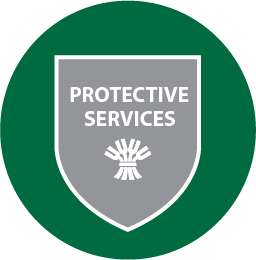Reporting options
There are two reporting options available to students and employees who have experienced sexual violence. You can report to Campus Protective Services and/or you can report to the municipal police or RCMP. These are two separate processes. For example, if you report to Campus Protective Services this does not constitute a report to the local police service and vice versa.
Option 1: Report through the university
Protective Services
306-966-5555
Protective Services can provide reporting persons with information concerning their options and rights.
When a report is made, Protective Services will notify the appropriate senior university leader. If the reporting person is a student, the Vice-Provost, Teaching, Learning and Student Experience will be notified. If the Reporting Person is an employee, the Associate Vice President People and Resources will be notified.
These senior university leaders are responsible for overseeing the university’s response to reports of sexual violence to ensure that the university’s processes unfold appropriately and to uphold all of the elements of the Policy on Sexual Assault Prevention.
Option 2: Report to municipal police or RCMP
You will need to report to the police station closest to where the incident occurred. If you are not in immediate danger, there are two ways to report to the police: you can call the municipal police or RCMP or you can go in-person to the municipal police station or RCMP detachment.
Saskatoon Police Service (or other police services outside of Saskatoon) will provide information relating to such things as filing a complaint, the criminal investigation process, and the likelihood that a criminal charge may be laid.
Preservation of information, material and medical evidence
When an individual intends to report sexual violence, it is important that any information, material and medical evidence relating to sexual assault or sexual misconduct is preserved for both possible police investigations and university investigations.
Anyone involved in an incident of sexual assault or sexual misconduct including individuals who are reporting, who are witnesses in the incident, or who are responding to the report are encouraged to preserve all information and material evidence relating to the incident. To make the collection of forensic data easier, the person who experienced the sexual violence should not shower, bathe, change or throw away clothes, disturb the area of occurrence, brush teeth, or comb hair. Other examples of information and material evidence include, but are not limited to, electronic communications (e.g., emails and text messages), photographs, and bedding.
What happens after you report
When Protective Services has received a report of sexual violence, the Reporting Person, the Accused Person, and anyone else involved in the incident will be offered appropriate support (in those cases where this has not already happened).
- Protective Services will ensure that medical attention is offered.
- Protective Services will ensure that the appropriate university personnel are mobilized to provide support including the Student Affairs and Outreach (when either the Reporting Person or the Accused Person is a student)
- All parties will be given comprehensive information about the university’s policy and procedures that apply to the situation and the associated steps or actions that can be taken including information about making a formal complaint.
Safety Assessment, Emergency Notification, and Campus Notification: Protective Services will conduct an initial assessment, including taking the steps necessary to ensure a safe environment for every individual involved in the incident being reported and other members of the campus community.
- Emergency Notification: In the event of an immediate imminent threat to the campus community, an Emergency Notification may be activated.
- Campus Notification: When not deemed an immediate imminent threat, it may still be necessary for the university to notify the wider campus (either in Saskatoon or at other U of S campus locations, or both) that sexual assault or sexual misconduct has taken place.
In making decisions about campus notification, consideration is given:
- The level of risk surrounding the event (e.g., the likelihood of further harm to members of the campus community)
- The wishes of the person who was reported to have been sexually assaulted.
- The opportunity to educate and build awareness within the campus community.
- When the Saskatoon Police Service is involved in a matter, the university must also give consideration to the obligation that campus notification does not interfere with an on-going criminal investigation.
This notification may include the following information
- Nature of the incident
- Date and time
- Place of the incident
- Description of the individual who has been accused of committing sexual assault or sexual misconduct.
Interim measures: The university may impose interim measures as may be appropriate for the individuals involved in the reported incident of sexual violence and for the larger campus community. Notably, interim measures are not intended to be punitive but are intended to provide a safe environment for all parties pending a determination of the allegations. Interim measures may include, but are not limited to:
- Separation of academic and living situations between the Reporting Person and Accused Person (in the case of student involvement);
- Separation of workplace situations (in the case of employees);
- Temporary suspension of the Accused Person (in the case of a student); or temporary modification of the Accused Persons academic program;
- Temporary suspension of the Accused Person or relocation of duties of the Accused Person (in the case of an employee)
- An order informing the Accused Person that they are prohibited from all or part of any campus of the University of Saskatchewan; and
- a no-contact order (i.e., an agreement, which is mutually undertaken by two or more parties, to refrain from contacting one another based on mutually specified conditions).
Seek help
After any incident, you may disclose your experience with a university staff member.
Make a complaint
Formal complaints allow the university to hold students or staff who have committed an offense to account.


